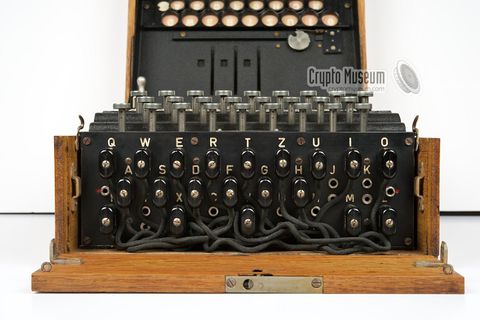Encrypting everything
From Gender and Tech Resources
Until it is destroyed [1], or we run out of resources to maintain its cables, bridges, root servers and data centers, or some idiot(s) replace(s) the current internet with a panopticon-like or a military-and-corporate-only global network, the web seems to be here to stay ... but it has an ad-hoc security model added post-hoc and it is up to us to make it better!?! WTF?


Before the digital age, the biggest users of cryptography were governments, particularly for military purposes. With the advent of the net we can all use it for:
- Enabling authorised transactions.
- Defending free expression.
- Protecting our space, our objects and channels, from unauthorised access.
- Collectively failing at putting crypto into our own hands.
This page is on the latter. See some of the below concepts applied in anonymising your traffic with linux (mostly channels), object encryption on linux and clean up all the things.
Contents
Crypto concepts

- The science of sending concealed messages is known as steganography (concealed writing). It is not very secure by itself. If someone finds the hidden message, all its secrets are revealed.
- Manipulating a message so that it can not be read even if it were intercepted is known as cryptography(hidden writing).
- Cryptography takes two forms: codes and ciphers.
- A code is essentially a secret language invented to conceal the meaning of a message, a system for hiding the meaning of a message by replacing each word or phrase in the original message with another character or set of characters (codegroups). The list of replacements is contained within a codebook. To protect a message in this way is called encoding. Encoding has no built-in flexibility.
- A cipherconceals a plaintext message by replacing or scrambling its letters. This process is known as enciphering and results in a ciphertext message. Converting a ciphertext message back to a plaintext message is known as deciphering. Each cipher can be split into two halves: the algorithm and the key. The key gives a cipher some built in flexibility.
- There are two classes of ciphers. A substitution cipher changes the letters in a message to another set of letters, or cipher alphabet, while a transposition cipher shuffles the letters around.
- Coded messages are often enciphered to improve their security, a process known as superencipherment.
- Encryption covers both the act of encoding and enciphering.
- Decryption covers both decoding and deciphering.
- Cryptotext covers both codetext and ciphertext but encicode is sometimes used instead.
- The science of breaking cryptotext or encicode is known as cryptanalysis.
- The two fields cryptography and cryptanalysis together make up the science of cryptology.
Most forms of cryptography used today rely on computers. Ciphers are better known today as algorithms, the guides for encryption -- they provide a way in which to craft a message and give a certain range of possible combinations. A key, on the other hand, helps a person or computer figure out the one possibility on a given occasion.
Symmetric-key encryption
In symmetric key cryptography (alias secret key cryptography) the same key is used to encrypt and decrypt the data.
There are many different algorithms using symmetric key cryptography, offering anything from minimal to nearly unbreakable security. Some of these algorithms offer strong security, easy implementation in code, and rapid encryption and decryption. Such algorithms are very useful for encrypting files stored on a computer to protect them in case an unauthorised individual gains access to the machine. They are somewhat less useful for sending messages from one computer to another, because both ends of the communication channel must possess the key and must keep it secure. Distribution and secure storage of such keys can be difficult and can open security vulnerabilities.
Data Encryption Standard (DES)
The Data Encryption Standard is a popular symmetric-key encryption method developed in 1975 and standardised by ANSI in 1981 as ANSI X.3.92. DES uses a 56-bit key and uses the block cipher method, which breaks text into 64-bit blocks and then encrypts them.
Triple DES, also referred to as 3DES, is a mode of the DES encryption algorithm that encrypts data three times. Three 64-bit keys are used, instead of one, for an overall key length of 192 bits (the first encryption is encrypted with second key, and the resulting cipher text is again encrypted with a third key).
Asymmetric key cryptography
In asymmetric key cryptography (alias public-key encryption) different keys are used for encrypting and decrypting a message. The asymmetric key algorithms that are most useful are those in which neither key can be deduced from the other. In that case, one key can be made public while the other is kept secure. This provides some distinct advantages over symmetric encryption: the necessity of distributing secret keys to large numbers of users is eliminated, and the algorithm can be used for authentication as well as for cryptography.
Diffie-Hellman key agreement
The Diffie-Hellman key agreement algorithm was developed by Dr. Whitfield Diffie and Dr. Martin Hellman in 1976 to enable two parties who are involved in communication to generate a shared secret key for exchanging information confidentially. It uses modular arithmetic https://en.wikipedia.org/wiki/Modular_arithmetic.
Modulus or modulo (abbreviated as "mod") is the Latin word for "remainder, residue" or more in "what is left after parts of the whole are taken". Thus, "modular" or "mod arithmetic" is really "remainder arithmetic". For example:
- When 7 is divided by 3 it leaves a remainder of 1, thus: 7 mod 3 = 1
- When 8 is divided by 3 it leaves a remainder of 2: 8 mod 3 = 2
- When 9 is divided by 3 it leaves no remainder: 9 mod 3 = 0.
Now imagine the following scene from Wuthering Heights:
- Cathy and Heathcliff exchange public keys. These keys must have the same modulo portion, a prime
p. (see RFC 5114) - Cathy and Heathcliff each encrypt a shared, non-secret value,
g(also usually taken from RFC 5114), using their private keys, and they exchange these encrypted values. - Cathy encrypts the encrypted value received from Heathcliff with her private key, and vice versa. These values are used as a shared session key.
For example, Cathy says: 5,23 (base g = 5 and prime number p = 23, randomly chosen by Cathy)
O_/ 7_O_/ _/| ---------------5,23--------------> (/ __)\ /\/' ` \ 7 Cathy Heathcliff
Heathcliff chooses a private number = x = 6 and says (gmy private number mod p = 56 mod 23 =) 8
O_/ 7_O_/ _/| <----------------8---------------- (/ __)\ /\/' ` \ 7 Cathy Heathcliff
Cathy chooses private number = y = 15 and says (gmy private number mod p = 515 mod 23 =) 19
O_/ 7_O_/ _/| -----------------19--------------> (/ __)\ /\/' ` \ 7 Cathy Heathcliff
- Cathy received the 8 from Heathcliff, and thinks, (heathcliffs public number)my private number mod 23 = 815 mod 23 = 2. Aha! Now I know the key is 2.
- Heathcliff comes to a similar conclusion using what Cathy shouted from afar (19) for the world to hear: 196 mod 23 = 2.
- And both encrypt their communication with 2.
This solves the problem of how to pass a secret key between two parties without having any eavesdropper knowing the key. This does not solve the man in the middle attack (authentication): Someone can pretend to be heathcliff and share a key with Cathy and Cathy will send encrypted information to "Heathcliff".
Rivest Shamir Adleman (RSA)
Ron Rivest, Adi Shamir, and Len Adleman released the Rivest-Shamir-Adleman (RSA) public key algorithm in 1978. This algorithm can be used for encrypting and signing data. The encryption and signing processes are performed through a series of modular multiplications http://mersennewiki.org/index.php/Modular_arithmetic.
It’s easy for a computer to multiply two large prime numbers together but if you gave this new number to a computer and asked it to tell you what prime numbers you multiplied to construct it, the computer would struggle. And the bigger the prime numbers get, the more the computer struggles, exponentially so. This is called a trapdoor, meaning it’s easy to go one way, but very hard to go the other. This mathematical difficulty is what ensures the strength of our encryption.
The RSA algorithm works as follows:
- Find two huge (at least 100 digits each!) prime numbers
pandq, and multiply them together to get the even bigger numbern. - Also combine p and q in a different way to generate another number e (details of this below).
- Publish these two numbers {n,e} as "public key", with the knowledge that there is enormous difficulty with even the world’s fastest computers breaking
ninto its constituent prime atomspandq. - The numbers {n,e} can be used by people to encrypt a message to send to me, and I can use my secret primes p and q to decrypt it.
In the unfolding love story, Heathcliff wants to encrypt and send Cathy his age (42 or forty-two). The RSA algorithm deals with sending numbers, but any text can be converted to digits in a variety of ways, so we can securely transmit information of any type.
- Cathy knows that Heathcliff wants to send her a message, so she selects two prime numbers, say p = 17 and q = 29 (n = p x q = 17 x 29 = 493).
- Cathy also needs to generate another number, e. She creates this number first by subtracting 1 off of each of her prime numbers p and q and then multiplies these two together ((p-1) x (q-1) = 448). This number is not e. The number e is allowed to be any number, which has no factors in common with this new number 448 (= 2 x 2 x 2 x 2 x 2 x 2 x 7). Now e is just any number which, when broken down into primes, does not possess a 2 or a 7 as a factor. There are lots of possibilities to choose from. Suppose Cathy picks e = 5.
- Cathy then gives the numbers n = 493 and e = 5 to Heathcliff.
==0 _O/ /\/ \ |\ /\_ / | \ ` oo oo `
- With these two numbers n and e, Heathcliff now encrypts his secret message: 42e mod n = 425 mod 493 = 42 x 42 x 42 x 42 x 42 mod 493 = 130,691,232 mod 493 = 383
- Cathy has received the number 383 from Heathcliff and needs to decrypt it to read it. Her first step, is to use her secret prime numbers p and q and the public number e to form another number d, which she can use to decrypt Heathcliff’s message. Cathy lists the multiples of 5: 5, 10, 15, 20, 25, 30, 35, 40 ... and the multiples of 448: 448, 896, 1344, 1792, 2240, 2688 ... to find a number in the first sequence which is exactly one more than a number in the second sequence. That is the 269th term which is 1345, one more than the 3rd term 1344 in the 448 sequence. d = 269.
- Now Cathy can decode the message by doing one big calculation. She has heathcliff's encrypted number, 383, and her new number, d = 269. The plaintext message = (ciphertext)d mod n = 383 269 mod 493 = 42
Basic RSA algorithm for confidentiality:
- Ciphertext = (plaintext)e mod n
- Plaintext = (ciphertext)d mod n
- Private Key = {d, n}
- Public Key = {e, n}
Basic RSA algorithm for authentication:
- Ciphertext = (plaintext)d mod n
- Plaintext = (ciphertext)e mod n
- Private key = {d, n}
- Public key = {e, n}
RSA is the best possible type of public key cryptography, yet due to the high computation involved it is often not used to encrypt/decrypt simple messages. Instead, it’s used for signatures and protocol negotiations to allow two sides to receive private keys to use for their communication. The RSA algorithm is but one of many systems where a set of mathematical theorems, often from number theory, can be synthesised to construct an encryption scheme.
==0 /\_. |\ / | oo oo
==0_/ /\_ |\ / | oo oo
==0_/ /\ |\ \ / | oo oo
_==0_/ |\ \_ / / oo oo
_O/
\
/\_
\ `
`
_O/ ,
\ / \O_
/\_ `\_\ ,/\/
\ ` , \ /
` O/ / /O\ \
/\|/\. `
Elliptic Curve Cryptography (ECC)
Elliptic Curve Cryptography provides similar functionality to RSA and is implemented in smaller devices like cell phones. It requires less computing power than RSA. ECC encryption systems are based on the idea of using points on a curve to define the public/private key pair.
El Gamal
El Gamal is an algorithm used for transmitting digital signatures and key exchanges. The method is based on calculating logarithms. The algorithm is based on the characteristics of logarithmic numbers and calculations. The Digital Signature Algorithm (DSA) is based on the El Gamal algorithm.
Digital Signature Algorithm (DSA)
The Digital Signature Algorithm (DSA) was developed by the United States government for digital signatures. DSA can be used only for signing data and it cannot be used for encryption. The DSA signing process is performed through a series of calculations based on a selected prime number. Although intended to have a maximum key size of 1,024 bits, longer key sizes are now supported.
Cryptographic hash functions
Digital signatures
Digital certificates
Cryptanalysis
Is the clock ticking for encryption?
Resources
- Hands-on Diffie–Hellman demonstration http://ds9a.nl/tmp/dh.html
Related
- Installing linux
- Linux applications
- Linux security
- Kinky linux command-line
- Object encryption on linux
- Anonymising your traffic with linux
- Clean up all the things
- Shell scripting
References
- ↑ How to destroy the internet http://gizmodo.com/5912383/how-to-destroy-the-internet